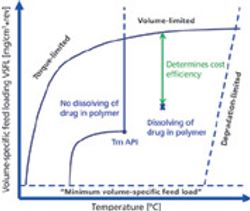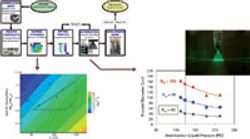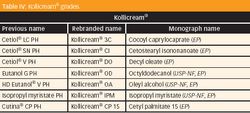Bioavailability Enhancement
Pharmaceutical Technology Europe
Soluplus®, a graft copolymer of PEG comprising polyvinyl acetate and polyvinyl caprolactam, was specially designed to solubilize poorly water-soluble drugs.
A solid solution
Soluplus®, a graft copolymer of PEG comprising polyvinyl acetate and polyvinyl caprolactam (see Figure 1A), was specially designed to solubilize poorly water-soluble drugs. To guarantee appropriate processability (e.g., in melt-extrusion applications), the composition of the polymer was adjusted to optimize its physical properties. With a low glass-transition temperature of around 70 °C, Soluplus® can be processed at low temperatures. Soluplus® shows good stability. Its formulations remain stable so that drugs, especially those that are formulated in an amorphous state, do not show recrystallization. In addition to these composition-related properties, the physical appearance of Soluplus® has been optimized. Using a special drying process, Soluplus® is formulated as free-flowing granules (see Figure 1B) that allow high feed rates and dust-free handling during the feeding process. At the same time the granules can easily be blended with most API crystals without showing segregation in subsequent process steps.
The unique chemical structure of Soluplus® enables it to interact with a large variety of chemical substances to form water-soluble complexes. Soluplus® is therefore considered suitable for increasing the bioavailability of many active pharmaceutical ingredients (APIs) that otherwise suffer from low solubility, which is a common attribute of most new chemical entities. In a previous study, it was shown that the bioavailability of fenofibrate, danazol and itraconazole was significantly increased when the drugs were formulated in a solid dispersion with Soluplus® via a melt-extrusion process (1) .
Figure 1: Chemical structure of Soluplus® (A) and physical appearance of the product (B).
Case study
Although the above mentioned study demonstrated the enhanced bioavailability of the investigated drugs, it also compared drug formulations with Soluplus® using only the crystalline form of the API. However, the crystalline form is not an ideal benchmark for comparison, considering that it is not optimized and is not expected to show comparable biovavailability.
Therefore, a new case study was performed by selecting the marketed formulation of a poorly-soluble drug (itraconazole) that had already been optimized with regard to the bioavailabity of the formulated API (2).
Sempera® is a formulation of itraconazole that contains sucrose, corn starch, hypromellose and PEG 20,000 in addition to the API (3). The product was used as a benchmark and compared with a Soluplus®-based itraconazole extrudate. The melt-extruded formulation (20% itraconazole, 80% Soluplus® was prepared with a 16 mm twin-screw extruder (Polylab, Thermo-Fisher, Germany) at 160 °C, 200 rpm and a feed rate of 1000 g/h. Before the formulations were compared in-vivo, characterization of certain properties was performed.
Figure 2: DSC thermograms show no crystalline itraconazole for the Soluplus® formulation (red). Interpretation for Sempera® was impossible due to overlaid peaks.
Differential scanning calorimetry (DSC) analysis showed the absence of any crystalline substances in the Soluplus® formulation (see Figure 2). Itraconazole in Sempera® seemed mainly amorphous, but an interpretation of the thermograms was impossible due to superimposed peaks from other excipients (PEG, sucrose).
Dissolution studies with the two formulations in simulated gastric fluid (USP) showed comparable dissolution profiles and a strong oversaturation of the drug in the release medium in both cases (see Figure 3).
Figure 3: Dissolution study of itraconazole formulations (USP paddle, 700 ml SGF). In both cases, a massive oversaturation could be achieved compared to the crystalline drug.
For the in-vivo study, each of the formulations was given to five beagle dogs in the form of an individually filled hard gelatin capsule that contained a dose of 10 mg of itraconazole per kg of body weight. Blood samples were taken at predefined sampling times and itraconazole plasma levels were analyzed by a chromatographic method.
Figure 4: Plasma level profiles in beagle dogs after administration of the different itraconazole formulations. The highest bioavailability was found for the Soluplus® formulation.
The test formulations were tolerated well and there were no clinical findings. Both formulations, Sempera® and Soluplus® extrudates, achieved a strong increase in bioavailability, compared with crystalline itraconazole (see Figure 4). However, the results from in-vitro dissolution tests and in-vivo plasma concentrations did not really correlate; the observed effect was much higher for the Soluplus®-based extrudate. The corresponding area under the curve (AUC 0-72 h ) increased more than two-fold compared to the Sempera® formulation (8.503 ng*h/mL versus 18.558 ng*h/mL).
Conclusion
This case study confirms the results obtained from previous studies and demonstrates once more that it is possible to achieve a significant increase in oral bioavailability with a Soluplus® formulation. Furthermore, the tested melt-extruded formulation was very easy to formulate and performed significantly better than the more complex marketed formulation. It is the authors' opinion therefore that Soluplus® can therefore help to bring promising new chemical entities to the market and shorten development times by an easy and fast formulation process via melt extrusion.
References
1. M. Linn et al., "Soluplus as an Effective Absorption Enhancer of Poorly Soluble Drugs In Vitro and In Vivo," Eur. J. Pharm. Sci., 45, 336–343 (2012).
2. F. Guth et al., "Bioavailability Enhancement of Itraconazole with Solid Solutions Based on Soluplus," presented at the 39th Annual Meeting and Exposition of the Controlled Release Society (CRS), Quebéc City, Canada 2012.
3. Rote Liste online, available at www.rote-liste.de/Online, accessed July 20, 2012.




